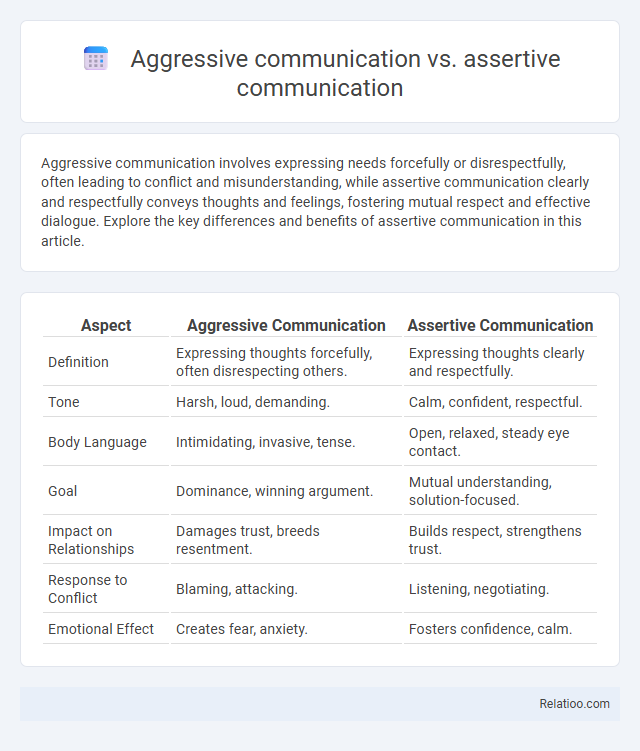Aggressive communication involves expressing needs forcefully or disrespectfully, often leading to conflict and misunderstanding, while assertive communication clearly and respectfully conveys thoughts and feelings, fostering mutual respect and effective dialogue. Explore the key differences and benefits of assertive communication in this article.
Table of Comparison
| Aspect | Aggressive Communication | Assertive Communication |
|---|---|---|
| Definition | Expressing thoughts forcefully, often disrespecting others. | Expressing thoughts clearly and respectfully. |
| Tone | Harsh, loud, demanding. | Calm, confident, respectful. |
| Body Language | Intimidating, invasive, tense. | Open, relaxed, steady eye contact. |
| Goal | Dominance, winning argument. | Mutual understanding, solution-focused. |
| Impact on Relationships | Damages trust, breeds resentment. | Builds respect, strengthens trust. |
| Response to Conflict | Blaming, attacking. | Listening, negotiating. |
| Emotional Effect | Creates fear, anxiety. | Fosters confidence, calm. |
Understanding Aggressive Communication
Aggressive communication involves expressing thoughts and feelings in a forceful, often hostile manner that disregards the rights and emotions of others. This style can lead to conflict, damaged relationships, and misunderstandings because it prioritizes winning over collaboration. Understanding aggressive communication helps you recognize its negative impact and shift toward assertive communication, which respects both your needs and those of others.
Defining Assertive Communication
Assertive communication involves expressing Your thoughts, feelings, and needs clearly and respectfully without infringing on others' rights, contrasting with aggressive communication that often violates boundaries through hostility or domination. This style promotes mutual understanding and problem-solving by balancing confidence with empathy. Mastering assertive communication enhances relationships and reduces conflicts by fostering honest and direct dialogue.
Key Characteristics of Aggressive Communicators
Aggressive communicators exhibit key characteristics such as a dominating tone, frequent interruptions, and a tendency to disregard others' feelings or opinions, often resulting in conflict or resentment. They prioritize winning conversations over mutual understanding, using blame or criticism as common tactics. This contrasts with assertive communicators who express their thoughts confidently while respecting others, and passive communicators who often avoid confrontation to keep peace.
Traits of Assertive Communicators
Assertive communicators exhibit clear, respectful, and confident expression of thoughts and feelings without infringing on others' rights. They maintain steady eye contact, use calm and steady tones, and listen actively while standing firm on their boundaries. Unlike aggressive communicators who may dominate or intimidate, assertive individuals foster mutual respect and effective problem-solving through balanced dialogue.
Psychological Impact of Aggressive Communication
Aggressive communication often leads to increased stress, anxiety, and decreased self-esteem in both the sender and receiver, creating a hostile psychological environment. Unlike assertive communication, which promotes clarity and mutual respect, aggressive communication triggers defensive behaviors and emotional withdrawal. Understanding these impacts helps you foster healthier, more constructive interactions by avoiding harmful aggressive tendencies.
Benefits of Assertive Communication
Assertive communication enhances Your ability to express thoughts and feelings clearly while respecting others' boundaries, leading to improved relationships and reduced conflicts. It fosters mutual understanding and boosts self-confidence by balancing honesty with empathy, unlike aggressive communication that often damages trust and creates hostility. Practicing assertiveness promotes effective problem-solving and emotional well-being, making interactions more productive and respectful.
Common Situations: Aggressive vs Assertive Responses
In common situations such as workplace conflicts or personal disagreements, aggressive communication often involves yelling, blaming, or dominating to win an argument, leading to damaged relationships and increased tension. Assertive communication, by contrast, allows you to express your feelings and needs clearly and respectfully, fostering mutual understanding and cooperation. Understanding the difference between these responses helps you maintain professionalism and build positive interactions even under pressure.
Barriers to Assertive Communication
Barriers to assertive communication often include fear of confrontation, low self-esteem, and lack of effective communication skills, which can cause you to default to aggressive or passive behaviors. Aggressive communication disregards others' feelings and rights, while passive communication neglects your own needs, both creating obstacles to clear and respectful dialogue. Overcoming these barriers requires self-awareness, emotional regulation, and confidence to express your thoughts assertively without hostility or submission.
Strategies to Shift from Aggressive to Assertive Communication
To shift from aggressive to assertive communication, individuals should practice active listening to understand others' viewpoints and express their own needs clearly and respectfully. Developing self-awareness by recognizing triggers and managing emotions helps prevent hostile reactions. Employing "I" statements and maintaining calm body language fosters open dialogue and mutual respect.
Building Healthy Relationships Through Assertiveness
Assertive communication fosters healthy relationships by expressing Your thoughts and feelings clearly and respectfully, promoting mutual understanding and trust. Unlike aggressive communication, which can harm connections through dominance and hostility, assertiveness encourages open dialogue without disrespecting others. Developing assertiveness skills enables stronger emotional bonds and reduces conflicts, creating a supportive environment for lasting relationships.

Infographic: Aggressive communication vs Assertive communication
 relatioo.com
relatioo.com